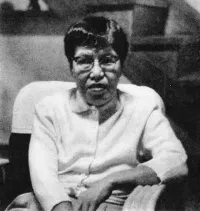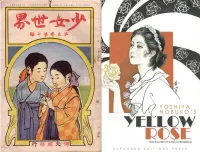Biography
1896 - 1973
“The sadness of those who love their own sex and therefore cannot live their lives in the form of a conventional marriage is redoubled by the chagrin of parents—for whom marriage represents the sole pinnacle of womanly achievement—and the opprobrium and scorn of everyone else.”
– Nobuko Yoshiya
Groundbreaker of Japanese lesbian literature, Nobuko Yoshiya, was born in the Niigata prefecture of Japan as the only daughter of parents from samurai families. She began writing while still in her teens. One of her early works, Flower Tales (1916-1924), a series of 52 stories of romantic friendships between women and girls, was popular among female students. Most of the tales in this series depict relationships filled with longing from afar or unrequited love. In 1919 Yoshiya wrote Two Virgins in the Attic, a semi-autobiographical tale describing a female-female love experience with a roommate. In the book’s final scene the two girls decide to live together as a couple. This strong feminist work attacked male-oriented society while revealing the author’s own lesbianism. Being an ‘out’ lesbian in Japan in the 1920s was extremely rare; yet, in spite of this, Yoshiya consistently ranked as one of the most popular writers in the country. In 1925 she began her own magazine, ‘Black Rose,’ but it ceased publication after only eight months. Her other major works include To the Ends of the Earth (1920), Women’s Friendship (1933), A Husband’s Chastity (1936), Demon Fire (1951), The People of the Ataka Family (1964), Tokugawa Women (1966), and Ladies of the Heiki (1971). Not all Yoshiya’s works depict same-sex romance between women. However, the many which did were considered suitable for girls and women of all ages since the lesbian attachments, though intense, were platonic and the relationships were seen as a transitory phase to heterosexuality and motherhood. Personally, Yoshiya made no secret of her relationship with life partner, Monma Chiyo, nor was she reticent about revealing the details of her personal life in interviews and essays. After her death in 1973 she willed her house in Kamakura to be used for women’s cultural activities. It is now the Yoshiya Nobuko Memorial Museum.
1896 - 1973
“The sadness of those who love their own sex and therefore cannot live their lives in the form of a conventional marriage is redoubled by the chagrin of parents—for whom marriage represents the sole pinnacle of womanly achievement—and the opprobrium and scorn of everyone else.”
– Nobuko Yoshiya
Groundbreaker of Japanese lesbian literature, Nobuko Yoshiya, was born in the Niigata prefecture of Japan as the only daughter of parents from samurai families. She began writing while still in her teens. One of her early works, Flower Tales (1916-1924), a series of 52 stories of romantic friendships between women and girls, was popular among female students. Most of the tales in this series depict relationships filled with longing from afar or unrequited love. In 1919 Yoshiya wrote Two Virgins in the Attic, a semi-autobiographical tale describing a female-female love experience with a roommate. In the book’s final scene the two girls decide to live together as a couple. This strong feminist work attacked male-oriented society while revealing the author’s own lesbianism. Being an ‘out’ lesbian in Japan in the 1920s was extremely rare; yet, in spite of this, Yoshiya consistently ranked as one of the most popular writers in the country. In 1925 she began her own magazine, ‘Black Rose,’ but it ceased publication after only eight months. Her other major works include To the Ends of the Earth (1920), Women’s Friendship (1933), A Husband’s Chastity (1936), Demon Fire (1951), The People of the Ataka Family (1964), Tokugawa Women (1966), and Ladies of the Heiki (1971). Not all Yoshiya’s works depict same-sex romance between women. However, the many which did were considered suitable for girls and women of all ages since the lesbian attachments, though intense, were platonic and the relationships were seen as a transitory phase to heterosexuality and motherhood. Personally, Yoshiya made no secret of her relationship with life partner, Monma Chiyo, nor was she reticent about revealing the details of her personal life in interviews and essays. After her death in 1973 she willed her house in Kamakura to be used for women’s cultural activities. It is now the Yoshiya Nobuko Memorial Museum.
Demography
Demography
Gender Female
Sexual Orientation Lesbian
Gender Identity Cisgender
Ethnicity Asian/Pacific Rim
Nations Affiliated Japan
Era/Epoch Modern Japan Shōwa Period (1926–1989) Modern Japan Taishō Period (1912–1926)
Field(s) of Contribution
Author
Journalism
Commemorations & Honors
Nobuko Yoshiya’s Chi No Hate Made Won a Osaka Asahi Shimbun Literary Prize
Nobuko Yoshiya's House Made Into Yoshiya Nobuko Memorial Museum (1973)
Demography
Gender Female
Sexual Orientation Lesbian
Gender Identity Cisgender
Ethnicity Asian/Pacific Rim
Nations Affiliated Japan
Era/Epoch Modern Japan Shōwa Period (1926–1989) Modern Japan Taishō Period (1912–1926)
Field(s) of Contribution
Author
Journalism
Commemorations & Honors
Nobuko Yoshiya’s Chi No Hate Made Won a Osaka Asahi Shimbun Literary Prize
Nobuko Yoshiya's House Made Into Yoshiya Nobuko Memorial Museum (1973)
Resources
Resources
Resources




